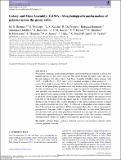Galaxy and Mass Assembly (GAMA) : morphological transformation of galaxies across the green valley
Abstract
We explore constraints on the joint photometric and morphological evolution of typical low redshift galaxies as they move from the blue cloud through the green valley and on to the red sequence. We select Galaxy And Mass Assembly (GAMA) survey galaxies with 10.25 < log(M*/M⊙) < 10.75 and z < 0.2 classified according to their intrinsic u* − r* colour. From single component Sérsic fits, we find that the stellar mass-sensitive K-band profiles of red and green galaxy populations are very similar while g-band profiles indicate more disc-like morphologies for the green galaxies: apparent (optical) morphological differences arise primarily from radial mass-to-light ratio variations. Two-component fits show that most green galaxies have significant bulge and disc components and that the blue to red evolution is driven by colour change in the disc. Together, these strongly suggest that galaxies evolve from blue to red through secular disc fading and that a strong bulge is present prior to any decline in star formation. The relative abundance of the green population implies a typical time-scale for traversing the green valley ∼1–2 Gyr and is independent of environment, unlike that of the red and blue populations. While environment likely plays a rôle in triggering the passage across the green valley, it appears to have little effect on time taken. These results are consistent with a green valley population dominated by (early type) disc galaxies that are insufficiently supplied with gas to maintain previous levels of disc star formation, eventually attaining passive colours. No single event is needed to quench their star formation.
Citation
Bremer , M N , Phillipps , S , Kelvin , L S , Propris , R D , Kennedy , R , Moffett , A J , Bamford , S , Davies , L J M , Driver , S P , Häußler , B , Holwerda , B , Hopkins , A , James , P A , Liske , J , Percival , S & Taylor , E N 2018 , ' Galaxy and Mass Assembly (GAMA) : morphological transformation of galaxies across the green valley ' , Monthly Notices of the Royal Astronomical Society , vol. 476 , no. 1 , pp. 12-26 . https://doi.org/10.1093/mnras/sty124
Publication
Monthly Notices of the Royal Astronomical Society
Status
Peer reviewed
ISSN
0035-8711Type
Journal article
Collections
Items in the St Andrews Research Repository are protected by copyright, with all rights reserved, unless otherwise indicated.
Related items
Showing items related by title, author, creator and subject.
-
SDSS-IV MaNGA: How the stellar populations of passive central galaxies depend on stellar and halo mass
Oyarzún, Grecco A.; Bundy, Kevin; Westfall, Kyle B.; Tinker, Jeremy L.; Belfiore, Francesco; Argudo-Fernández, Maria; Zheng, Zheng; Conroy, Charlie; Masters, Karen L.; Wake, David; Law, David R.; McDermid, Richard M.; Aragón-Salamanca, Alfonso; Parikh, Taniya; Yan, Renbin; Bershady, Matthew; Sánchez, Sebastián F.; Andrews, Brett H.; Fernández-Trincado, José G.; Lane, Richard R.; Bizyaev, D.; Boardman, Nicholas Fraser; Lacerna, Ivan; Brownstein, J. R.; Drory, Niv; Zhang, Kai (2022-07-06) - Journal articleWe analyze spatially resolved and co-added SDSS-IV MaNGA spectra with signal-to-noise ratio ∼100 from 2200 passive central galaxies (z ∼ 0.05) to understand how central galaxy assembly depends on stellar mass (M*) and halo ... -
Secular-and merger-built bulges in barred galaxies
Mendez Abreu, Jairo; Debattista, V. P.; Corsini, E. M.; Aguerri, J. A. L. (2014-12) - Journal articleContext. Historically, galaxy bulges were thought to be single-component objects at the center of galaxies. However, this picture is now questioned since different bulge types with different formation paths, namely classical ... -
Galaxy And Mass Assembly (GAMA) : galaxy close pairs, mergers and the future fate of stellar mass
Robotham, A. S. G.; Driver, S. P.; Davies, L. J. M.; Hopkins, A. M.; Baldry, I. K.; Agius, N. K.; Bauer, A. E.; Bland-Hawthorn, J.; Brough, S.; Brown, M. J. I.; Cluver, M.; De Propris, R.; Drinkwater, M. J.; Holwerda, B. W.; Kelvin, L. S.; Lara-Lopez, M. A.; Liske, J.; Lopez-Sanchez, A. R.; Loveday, J.; Mahajan, S.; McNaught-Roberts, T.; Moffett, A.; Norberg, P.; Obreschkow, D.; Owers, M. S.; Penny, S. J.; Pimbblet, K.; Prescott, M.; Taylor, E. N.; van Kampen, E.; Wilkins, S. M. (2014-11-11) - Journal articleWe use a highly complete subset of the Galaxy And Mass Assembly II (GAMA-II) redshift sample to fully describe the stellar mass dependence of close pairs and mergers between 10(8) and 10(12)M(circle dot). Using the analytic ...

